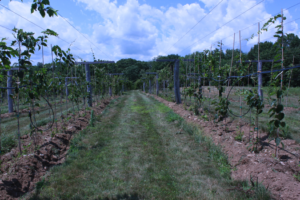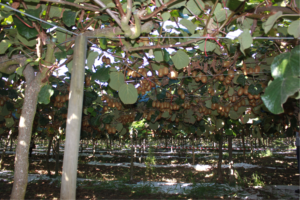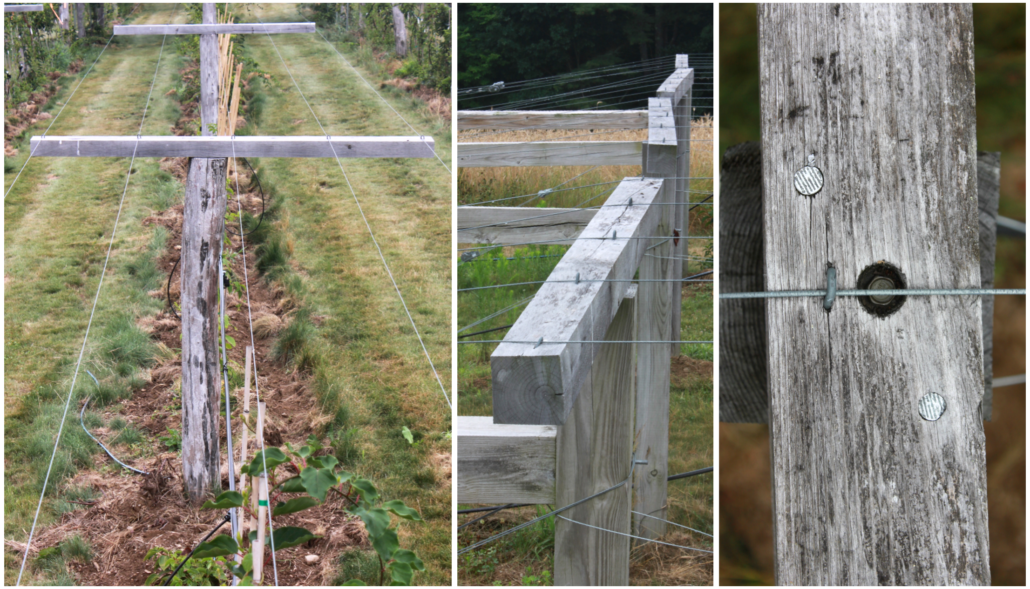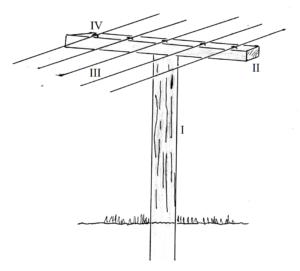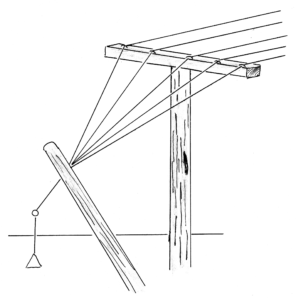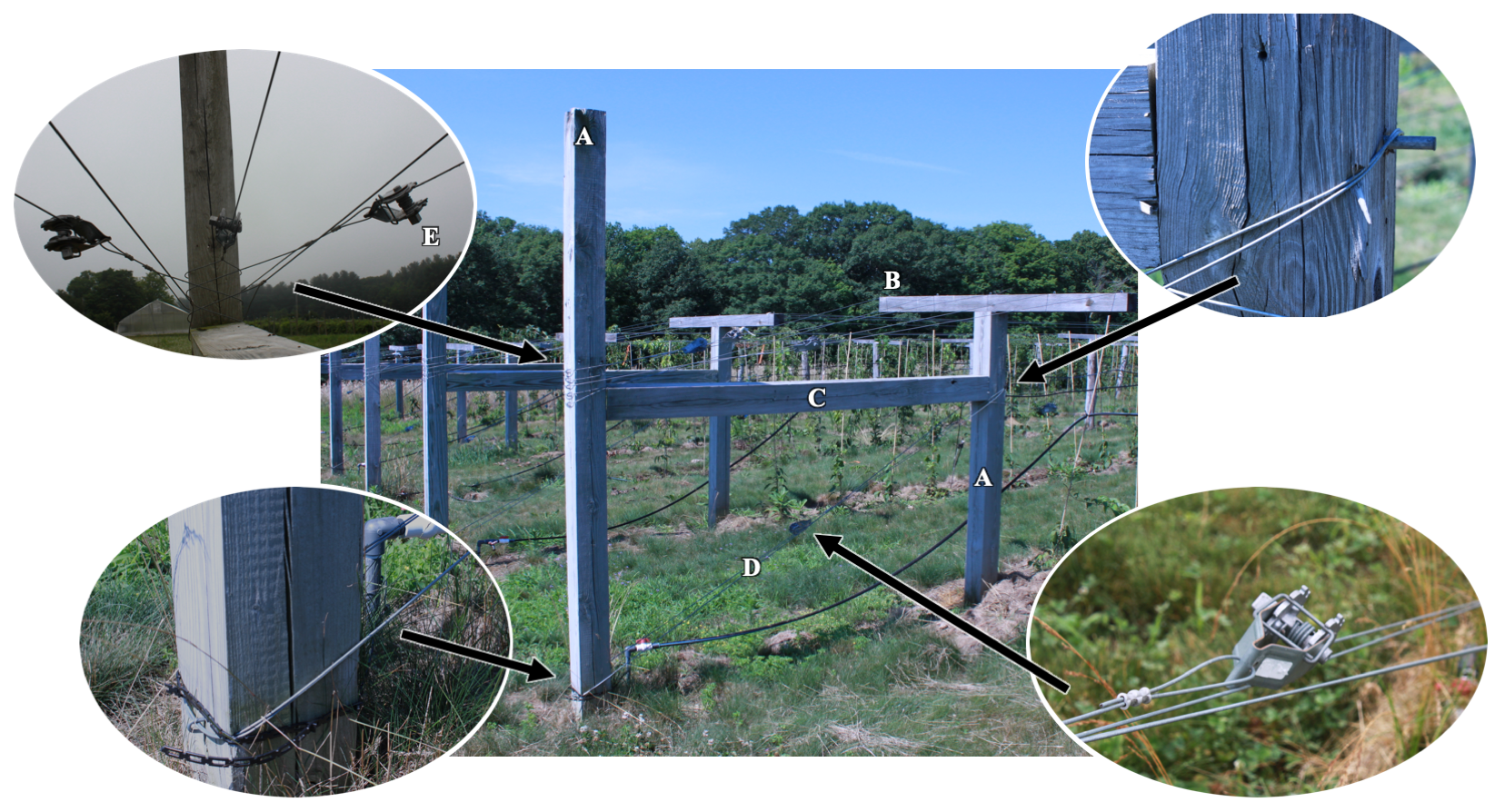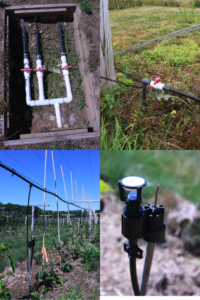Vineyard Establishment
Site Selection
Proper site selection will positively influence kiwiberry vine health, maturation, and productivity in the long term. To begin, the site of the vineyard should be relatively well-drained; at a bare minimum, to avoid waterlogging of roots, the site should be free of standing water throughout the year. Commercial kiwiberry plantings in Oregon have suffered losses from phytophthora root rot due to excessive moisture (Strik & Hummer 2006). Long-term observations of commercial vineyards in northern Europe indicate that kiwiberry vines grown in sandy-loam, well-drained soils are more productive than those planted in heavy soils (F. Debersaques and P. Latocha, pers. communications). Appropriate sites must also be irrigable as needed throughout the season, with the establishment period (Years 1-4) being a particularly essential time to avoid water stress.
When considering potential sites, it is worth remembering that kiwiberry is a woody, perennial crop planted at relatively low density (~400 vines per acre); therefore, vineyards need not be limited to high-quality, flat, and/or tillable agricultural fields. Plots with undulating terrain or large field stones and boulders should not be discounted as options. Vineyards should, however, be sited such that they receive full sun exposure, as this will accelerate vineyard establishment and maximize production.
As with many northern-latitude fruit crops, important factors which should be taken into consideration when siting kiwiberry vines are the slope and aspect of the land. If available, a north-facing slope is preferred as a means of mitigating wide temperature swings in the spring that can accelerate emergence from winter dormancy. By extending the period of vine dormancy, a north-sloping site can help reduce the risk of damage from late-spring frost events. Even if a northern aspect is unavailable, sites should have good air drainage because vines growing in depressions or valleys are at greater risk of chilling injury than those growing on well-drained slopes.
If possible, sites with consistently high winds or those prone to heavy gusting should be avoided to prevent unnecessary mechanical damage to vines, bloom loss during flowering, and fruit rubbing which can lead to cosmetic defects in the berries. That being said, if the only available site is windy, the installation of a well-designed windbreak can mitigate these issues. The use of windbreaks to slow wind speed is considered to be an essential practice in fuzzy kiwifruit production (McAneney et al. 1984) and may benefit all kiwiberry production sites. Common practice dictates that windbreaks should be a minimum of 10x longer than they are tall and spaced no more than 10x their height between windbreaks (Brandle & Hodges 2006); however, such standardized recommendations should be used with caution (Finch 1988). Effective windbreaks must take into account primary windspeed and direction; windbreak height, spacing, and composition; as well as other production limitations and site features (McAneney et al. 1984; Finch 1988). The prevailing wind direction may also influence pollination efficiency, and growers may want to consider planting a higher density row of male plants upwind of the prevailing wind direction (see Pollination section).
In terms of previous cropping history, sites affected by root knot nematodes (Meloidogyne spp.) or verticillium wilt should be avoided, as should those previously covered with oak or walnut trees, the former due to kiwiberry’s presumed susceptibility to Armillaria oak root fungus (Strik 2005) and the latter to the potential sensitivity of Actinidia spp. to the allelopathic compound juglone (R. Guthrie, pers. communication).
Finally, the construction of a fence or other plant protection systems may be prudent based on local vertebrate pest population levels (see Non-insect pests section for further information).
Site Preparation
Once an appropriate site is identified, time should be taken to develop it carefully, preparing a solid foundation for successful vine establishment and long-term productivity. The importance of such preparation is underscored by the fact that the expected lifetime of a vineyard may be anywhere from 20 to 50+ years (R. Guthrie and D. Jackson, pers. communications). To begin, the site should be cleared of all debris and rocks, as required, to facilitate efficient trellis installation and projected equipment use. Hidden stones can split posts, if using a post-pounder, as well as damage cultivation equipment. If a hardpan is present, an initial series of cultivations may be necessary to improve the soil structure, followed by subsequent passes for the incorporation of any soil amendments. It is recommended that the entire production site be subjected to initial cultivation, rather than just the areas where planting will occur, as full site cultivation will help to suppress long term weed pressure and provide a clean site for the establishment of both the vines themselves and the alleyways.
For optimum vine health and productivity, it is important to establish and maintain a soil pH between 5.5-6.5 (Strik 2005), a level necessary to reduce vine stress and enable efficient nutrient uptake. A pH level above 7.0 can cause chlorosis, particularly in red-fruited cultivars (P. Latocha, pers. communication). A preplant soil test is strongly recommended, and all necessary steps should be taken to ensure an informative and representative analysis. For example, soil samples should be taken throughout the prospective site in such a way as to account for known differences in previous use and other site characteristics (e.g. soil texture, moisture, etc.). Ideally, the samples submitted for analysis should be homogenized mixtures of multiple subsamples taken throughout each vineyard section being screened, with the required amounts specified by the soil lab being used. Even under presumably uniform field conditions, an individual submitted soil sample should not be considered representative of more than approximately one acre.
Proper soil fertility, including sufficient soil organic matter, is of primary importance to vine establishment and productivity, as kiwiberry is sensitive to both macro- and micro-nutrient deficiencies (Decorte 2018). Although precise preplant fertilizer and soil amendment recommendations are currently unavailable for kiwiberry, growers should do their best to provide sufficient annual levels of N, P, and K (see Fertilization section for details). Research is currently needed to develop best practices for soil and foliar nutrient management, and growers are encouraged to observe how their specific cultivars respond to nutrient stress and amendment.
In addition to establishing the vines themselves, growers should approach initial site preparation with an eye toward proper vineyard floor (i.e. alleyway) establishment as well. The alleys influence vineyard health and productivity in many ways, including reducing soil runoff, mitigating nutrient loss, buffering soil temperature, and controlling weeds (Huang 2014). Bunching species of cover crops (e.g. fescue, orchard grass, etc..) are recommended to prevent creeping into cultivated areas, thereby reducing resource competition between the cover and commercial crops. At least one experienced grower who has experimented with various cover crops has concluded that light-colored grass species facilitate sunlight bounce into the underside of the canopy, with beneficial effects on fruit quality, notably °Brix and blush (D. Jackson, pers. communication). After first experimenting with clover species, the NHAES kiwiberry program now uses light-colored, fine-leafed, bunching fescue (a Chewings fescure mix) seeded at a rate of 5 lbs per 1,000 feet2 and mowed to a height of 1.5-2.0 inches, as needed (Fig 15). Due to the unavoidable heavy alleyway traffic during trellis establishment, growers are advised to establish the vineyard floor cover after trellis construction is completed. See the Cultivation section for details on how to manage the vineyard floor after its initial establishment.
Trellis System
Economically viable kiwiberry production depends critically on the intensive management of vines supported by a robust trellis system. Apart from the vines themselves, this support infrastructure is arguably the most important, and certainly the most capital-intensive, element of a kiwiberry vineyard. In addition to supporting the sizeable fruit loads produced by commercially-spaced mature vines (up to 100 lbs. per vine), a strong, well-constructed trellis system is required to bear the weight of substantial vegetation as well as its associated ice and snow loads during the winter months. Quite different from the training techniques common in grape production (e.g. the Vertical Shoot Positioning system), the ideal canopy in a commercial kiwiberry vineyard is a horizontal plane of vegetation resting directly atop a series of support wires. Unfortunately, such a large vegetative and fruit-bearing area presents an ideal location for snow buildup; so trellis design should honor regional weather expectations. In light of the expected lifespan of the vines, commonly 30 years or more, growers should take care to invest in building materials with a minimum expected working life of 20 years. While the costs of such materials, not to mention their installation, may be higher than those associated with other crops, investing the time and resources to ensure a high-quality product is well worth the effort over the life of the vineyard.
The fuzzy kiwifruit and the kiwiberry are grown on different trellis systems to meet their distinct production needs. The fuzzy kiwi is most commonly grown on a pergola, consisting of a dense grid of high-tension wires (Fig 16). Such a system accommodates the significantly greater fruit load and shading requirements of the fuzzy kiwifruit. In contrast, the recommended practice for the relatively more vegetatively vigorous kiwiberries is to grow them on an open row trellis system referred to as a ‘T-bar’ system, in which the vines are trained to a horizontal plane of parallel wires supported by a row of T-shaped posts (Fig 17).
Although some kiwiberry producers have been known to use pergolas, we strongly recommend the T-bar system for several reasons. First, by maintaining clear separations between rows, the system facilitates pruning access, thus simplifying the task of preventing within- and between-row vine entanglements. Opening the canopy results in a suite of other benefits as well, including increased airflow to reduce humidity and thus instances of fungal disease; better pollinator access (Strik 2005); and greater sunlight penetration to developing and ripening berries, with its associated beneficial effects on fruit quality. Specifically, direct exposure to sunlight has been observed to increase total sugar levels as well as to promote attractive red blushing in several cultivars. Finally, T-bar systems are simpler and less expensive to build than pergolas; and the open alleyways permit the movement of a small tractor for cultivation.
As shown in the accompanying photos and schematic (Figs 17-18), the in-row T-bars used in the NHAES program consist of the following components:
- Support post The in-row support posts are 8-9 feet long × 6-9 inch diameter wooden poles, buried or pounded 2-3 feet into the ground, such that the top of the posts are 6 feet above ground. The distance between support posts is 32 feet, which accommodates 2-3 vines between posts (at a plant spacing of 16 feet or ~10 feet, respectively). Note that the post height may be adjusted based on the management requirements of the grower, such that the canopy is at a comfortable height to prevent undue exertion during pruning and harvest. Although black locust poles are used in the NHAES vineyard, other materials will work as well (see below).
- Cross bar A board rests horizontally atop each support post, completing the ‘T’ shape. The cross bar runs perpendicular to the row and provides direct support to the set of parallel wires in each row. At the NHAES, each rough-sawn pine bar (6 feet long × 4 inches high × 6 inches wide) is secured to a support post via two 6 inch lag bolts into the end-grain of the post.
- Support wires Five parallel, high-tensile lateral support wires run the length of each row, resting directly on the cross bars. The wires should be evenly spaced along the 6 foot cross bars (i.e. 18 inches apart), one on center and two on either side of center. Additionally, we recommend using 12.5 gauge (2.5 mm diameter) wire to ensure compatibility with many common “clip-to-wire” fasteners used for tying down lateral shoots (see Appendix I ‘Grower Resources’). A high tensile wire dispenser, also known as a Spinning Jenny, should be used to efficiently run wire.
- Cable staples To guide the five wires and maintain their relative spacing, five 1.5-1.75 inch galvanized barbed staples are driven into the top surface of each cross bar. To facilitate installation and to accommodate thermal expansion and contraction of the wires, the staples should be firmly secured while still allowing enough space for each wire to slide back and forth.
As mentioned at the beginning of this section, trellis materials should be selected with a minimum expectation of a 20 year lifespan, primarily because replacing supporting infrastructure under the weight of mature vines can be very difficult (R. Guthrie, pers. communication). Although concrete and pressure-treated wood are both common trellis post materials, the NHAES program uses regionally-sourced black locust posts (see Appendix I ‘Grower Resources’), noted for their rot resistance. If using black locust, try to source poles that have been seasoned for at least 2 years, because fresh poles may still contain moisture and thus be partially susceptible to rot. If freshly harvested posts are used, it is recommended to char their ends before using, as this will help remove remaining moisture and seal the ends of the logs.
Some sort of anchoring system is needed at the ends of each row of T-bars, against which the wires can be pulled into tension. Wires under high tension (i.e. no slack) are required to train vines into their desired architecture and support their weight under fruit set. Adjustable hardware that permits both tensioning and loosening is recommended, as wires will need to be adjusted seasonally due to thermal expansion and contraction, which can place undue stress on wires under static tension.
One option is an earth anchor (Fig 19), a system reportedly common in vineyard and orchard production systems in the Midwest (R. Guthrie, pers. communication). In this system, the soil anchor is sunk to the maximum depth obtainable to provide maximum hold. The five high tension wires are then secured to the earth anchor and then threaded through an end post, sunk on angle. If earth anchors are used, the vineyard end-post should be of a larger diameter than the in-row posts and installation is best done in the spring when soils are moist. As an alternative to earth anchors, the NHAES vineyard relies on H-braces (Fig 20), an anchoring system we find more appropriate due to the high volume of field stones on site and concerns over seasonal freeze-thaw ground movement. As single earth anchors have not been trialed at the NHAES, this guide provides relatively more detail about the H-brace system. Producers interested in further information about earth anchor construction should consult Appendix I ‘Grower Resources’.
Below are the specifications of the components comprising the H-braces in the NHAES vineyard (Fig 20):
- Support posts Similar to the support posts for the T-bars, each H-brace requires two 9 foot long × 8 – 9 inch diameter black locust poles. The inner post is buried or pounded 3 feet into the ground, such that its top is 6 feet above ground. The outer post is buried or pounded 4 feet into the ground, such that its top is 5 feet above ground. The two posts are spaced 8 feet apart, in row.
- Cross bar The inner post functions as the terminal T-bar for the row; thus it requires a cross bar, as described previously.
- H-beam This 4 inch × 4 inch × 8 foot pine beam, installed horizontally between the two support posts at a height of 4 feet off the ground, maintains the verticality of the support posts and provides counterforce to the diagonal tensioning wire. This beam is held in position by 10-12 inch galvanized brace pins. One pin is sunk halfway into the support post while the other is driven completely through, allowing the H-beam to be placed.
- Diagonal tensioning wire Pulling the two support posts together against the H-beam is a diagonally mounted loop of 12.5 gauge wire, held under tension by a strainer. The vertical position of the wire against the inner post is maintained by its resting on the protruding end of the inset rod. On the outer post, its position is maintained by a barbed wire staple.
- Wire tensioners Once the H-brace is constructed, five wire tensioners can be secured to the outer post via five loops of wire, each anchored by a wire staple. Each tensioner then receives one of the five trellis wires, which can then be brought into tension.
Please note that the spacing between rows (i.e. alley width) should be carefully considered before installing the trellis system. A row spacing of 10 feet – 8 inches (center-to-center) has been found to work well in the NHAES vineyard, allowing sufficient working room within the aisles and movement of our specific equipment through the vineyard (see Cultivation section). T-bars extend ~2 feet into the alleyway on either side, allowing for ~5.5 – 6 feet of working room within aisles.
Irrigation System
The needed frequency and extent of irrigation will vary across years and within seasons and will also closely depend on a range of site- and operation-specific factors such as soil texture, soil quality, aspect, slope, and the age of the vines. As mentioned above, kiwiberry vines do not tolerate excessive water or poorly drained soils. Indeed, overall growth will be severely impacted if the rootzone is waterlogged for more than 3 days (Strik 2005; P. Latocha, pers. communication). On the other extreme, plants can also suffer a range of short-to-medium term production setbacks if exposed to drought stress (Huang 2014), including poor in-season growth (e.g. lateral renewal), increased susceptibility to subsequent winter damage, and prolonged juvenility (i.e. establishment period). The NHAES vineyard is maintained to receive a target of 4 inches of rainfall or irrigation per month during the active growing season (May-September). In the fall, as vines harden off in preparation for winter dormancy, access to adequate moisture is essential to avoid undue dieback of current season growth. The established practice in fuzzy kiwifruit production is to irrigate when soil water content falls below 60% field capacity (Huang 2014); and until further research shows otherwise, we recommend a similar approach in kiwiberry production.
The amount of water applied may have little relationship to the amount of water available to and taken up by the vines; so a well-designed irrigation system, combined with efficient application practices, can greatly reduce operational costs. While subsoil drip irrigation systems have been reported to increase effective water utilization by up to 95% (Huang 2014), such systems are not the observed standard in the Northeast. Rather, the NHAES recommendation for kiwiberry production is an elevated system in which the irrigation lines are suspended approximately 4 feet off the ground, attached to an in-row support wire (Fig 21).
There are multiple benefits to such a system. Raising the irrigation line prevents accidental damage which may occur during regular mowing or cultivation operations. Irrigation components can be accessed, serviced, and/or replaced easily, something important to consider with a long-lived crop like kiwiberry. Finally, when paired with microsprinklers or shower-head emitters, such a system enables the fair distribution of water throughout the expanding rootzone, which in general will equal or exceed the canopy area (D. Jackson, pers. communication).
When designing the irrigation system for a kiwiberry vineyard, consider the following factors:
- Based on your water supply, what is the maximum flow rate (e.g. gal/hr) that can be supplied to the vineyard and at what pressure? This will influence decision-making around the need for zoning and the choice of emitter type.
- Apart from the inherent limitation of maximum flow rate, is zoning of the vineyard required for other reasons (e.g. differential soil properties, differently aged vines, etc.)?
- Finally, is mechanical cultivation planned and, if so, with what implements? Irrigation lines should run high enough off the ground to prevent accidental damage to them during cultivation.
How do we irrigate at the NHAES?
|
Fig 15 The low maintenance alleyways of fine-leafed Chewings fescue alleyway in the NHAES breeding vineyard provide good weed suppression. The alleyway was seeded at 5 lbs per 1,000 ft2.
Fig 16 Fuzzy kiwifruit (Actinidia chinensis var. deliciosa) trained to a pergola trellis system in Northern Spain.
Fig 17 Details of the T-bar trellis system installed at the NHAES Woodman Horticultural Research Farm. Right to left: An aerial view of the T-Bar, the cable staples guiding the 12 gauge wires, and the mounting bolt and nails securing the cross bar to the post.
Fig 18 Schematic of the T-bar system used at the NHAES vineyard: I) The support post for the T-bar structure; II) The top bar upon which the set of five 12 gauge support wires rest; III) The support wires. IV) The cable staples which secure the wires to the top bar and guide them down the row.
Fig 19 Schematic of an earth anchor system, where the terminal T-bar in a row is is anchored by a single sunken soil anchor. The set of five support wires pass through an intermediate, angled post to facilitate increased wire tension.
Fig 20 Details of the H-brace system used in the NHAES vineyard to anchor the ends of rows. In this system, two support posts (A) are set into the ground, and the inner post is mounted with a cross bar (B). Spanning the distance between the two support posts is the H-beam (C), mounted approximately 4 feet off the ground with brace pins. A diagonal tensioning wire (D) pulls the H-brace into rigidity. Finally, wire tensioners (E) are used to strain the five support wires, with three on one end of the row and two on other, to avoid crowding.
Fig 21 The NHAES irrigation system uses a zoned header to deliver water to targeted locations within the vineyard. Further irrigation control is available at the point of connection between the header pipe and each row’s irrigation hose via a stop-value. The suspended in-row irrigation lines keep the cultivation area clear for mowing and cultivation. To facilitate both minor re-positioning and potential use in frost protection of the canopy, a length of spaghetti tubing runs between the irrigation line and each microsprinkler emitter.

